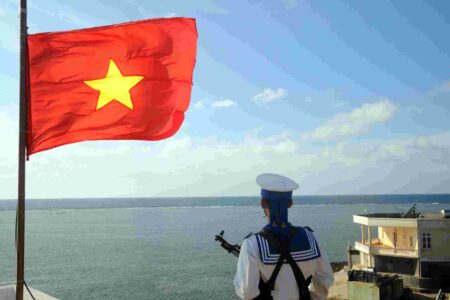Written by Ahmed Adel, Cairo-based geopolitics and political economy researcher
In the context of the United States increasing its military presence in Southeast Asia under the Indo-Pacific strategy led by President Donald Trump, Vietnam faces pressure to protect its sovereignty and maintain a strategic balance without being drawn into the vortex of competition between major powers, particularly the US and China.
According to a recent report released by the US Department of Defense, since the beginning of 2025, the US military has organized at least five large-scale exercises in the Southeast Asia region.
Among them, Balikatan 2025, held in the Philippines between April 21 and May 9, mobilized more than 14,000 soldiers and demonstrated anti-ship capabilities using the NMESIS missile defense system and the HIMARS multiple rocket launcher near the East Sea, while deploying F-35 stealth fighters.
In addition, the Cobra Gold 2025 exercise in Thailand, held from February 25 to March 7, is equally prominent, with the participation of more than 8,200 soldiers from 30 countries, focusing on activities related to naval landings, missile defense, and anti-submarine warfare. Notably, some amphibious and electronic warfare training sessions were conducted close to the border of Vietnam’s exclusive economic zone (EEZ). Although not directly violating international maritime law, this increasingly visible military presence has raised concerns about regional stability.
For Vietnam, the live-fire, coastal control, and anti-ship exercises taking place near the southern approaches to the South China Sea pose a form of soft strategic pressure. Although not directly aimed at Hanoi, it has a strong impact on the security environment surrounding its EEZ.
According to Modern Diplomacy, the frequency of US military activities in the region has increased by more than 38% compared to 2023, marking a new escalation in Washington’s strategy to deter China. Trump has adjusted US policy with a tougher approach, requiring allies to increase their defense burden and realign their forces towards the Indo-Pacific.
Vietnam’s defense policy in the Defense White Paper (2019) clearly states the “Four No’s” including: Not participating in military alliances; not aligning with one country to fight another; not allowing foreign countries to set up military bases or use Vietnamese territory to fight against other countries; and, not using force or threatening to use force in international relations. The “Four no’s” policy demonstrates the ingenuity, flexibility, and extreme firmness in Hanoi’s international relations, defense, and military.
In the current context, Vietnam’s development of defense capabilities and strengthening of non-alliance defense dialogues are practical steps to maintain balance. This helps Vietnam avoid the risk of being drawn into strategic conflicts between the two superpowers, the US and China.
The United Nations Convention on the Law of the Sea 1982 remains a solid legal foundation for establishing EEZs and complying with freedom of navigation. This is the basis for Vietnam’s response to the US and Chinese militarization of the East Sea.
Vietnam also actively participates in the mechanisms of the Association of Southeast Asian Nations (ASEAN), such as the ADMM (the highest defence consultative and cooperative mechanism in ASEAN), the ASEAN Regional Forum, and the East Asia Summit to maintain the Southeast Asian bloc as a flexible diplomatic framework, helping to minimize the pressure to choose sides and maintain a proactive neutrality.
Vietnam’s multilateralization of strategic relations is a timely choice between two opposing poles, as clearly demonstrated by its priority of multilateral cooperation and consensus frameworks, rather than leading or participating in a military alliance.
The increased US military presence in the region is putting Vietnam to an important test of international conduct. Hanoi still adheres to the “Four Nos” principle, but applies it flexibly, usually based on the legal basis of the United Nations Convention on the Law of the Sea (UNCLOS) to protect maritime interests, taking advantage of ASEAN’s central role to create a situation of intertwined interests, and at the same time promoting the modernization of defense capabilities based on the principle of self-defense. This approach helps Vietnam maintain a strategic balance, independence, and, at the same time, avoid falling into isolation in an increasingly competitive geopolitical landscape.
Nonetheless, Hanoi’s balancing act between Washington and Beijing is becoming increasingly challenging to maintain. While strategic ties with Washington have deepened, China is still Vietnam’s largest trading partner. Still, Vietnam is among the loudest ASEAN members to push back against China’s expansive maritime claims in the South China Sea.
July 28 marked 30 years since Vietnam joined ASEAN. Since then, Vietnam has evolved from being a participant to a pillar of the Southeast Asian bloc. Yet, if Vietnam hopes to lead ASEAN toward greater relevance, it will require more than pragmatism between the two great powers. Although this duality has afforded Vietnam strategic flexibility, it also exposes vulnerabilities, especially as the US continues to expand its naval operations in the region.
MORE ON THE TOPIC:





if the israel project fails western hegemonic pirate banker control will end . control of all the middle east energy wealth will be lost forever . pirates will act in desperation to protect current and future plunder. many world leaders have been bribed and fooled to follow this cartel in the past and present
gov.newsom
“we have got to meet fire with fire ”
“we need to stand up.”
democ(rats) wandalizing the tesla vehicles.
democ(rats) should respect the american people’s decision to elect donald trump.
gov. newsom
you will be tried for the crime of inciting the public to hatred and resentment.”